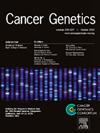70.由原发性血小板增多症转化而来的新型 AKAP9::PDGFRA 融合急性髓性白血病
IF 1.4
4区 医学
Q4 GENETICS & HEREDITY
引用次数: 0
摘要
急性髓性白血病(AML)是一种异质性血液恶性肿瘤,与基因突变、表观遗传学异常和染色体重排相关基因融合的各种组合有关。尽管急性髓细胞性白血病的发病机制存在很大程度的异质性,但许多基因融合和点突变在急性髓细胞性白血病中反复出现,并在过去几十年中被用于风险分层。基因融合在了解肿瘤发生方面早已得到认可,并在临床诊断和靶向治疗中发挥着成熟的作用。DNA 测序技术和计算生物学的进步极大地促进了已知融合基因的检测和新型融合基因的发现。急性髓细胞性白血病中一些反复出现的基因融合与预后、治疗反应和疾病进展有关。在此,我们介绍了一例长期患有原发性血小板增多症和标志性 CALR 基因突变的病例,该病例转变为急性髓细胞性白血病,其特点是存在以前未报道过的 AKAP9::PDGFRA 融合基因。我们提出了这种融合可能导致急性髓细胞性白血病发病机制的机制,以及其作为酪氨酸激酶抑制剂分子靶点的潜力:白血病研究报告本文章由计算机程序翻译,如有差异,请以英文原文为准。
70. Acute myeloid leukemia with a novel AKAP9::PDGFRA fusion transformed from essential thrombocythemia
Acute myeloid leukemia (AML) is a heterogeneous hematological malignancy associated with various combinations of gene mutations, epigenetic abnormalities, and chromosome rearrangement-related gene fusions. Despite the significant degree of heterogeneity in its pathogenesis, many gene fusions and point mutations are recurrent in AML and have been employed in risk stratification over the last several decades. Gene fusions have long been recognized for understanding tumorigenesis and their proven roles in clinical diagnosis and targeted therapies. Advances in DNA sequencing technologies and computational biology have contributed significantly to the detection of known fusion genes as well as for the discovery of novel ones. Several recurring gene fusions in AML have been linked to prognosis, treatment response, and disease progression. Here, we present a case with a long history of essential thrombocythemia and hallmark CALR mutation transforming to AML characterized by a previously unreported AKAP9::PDGFRA fusion gene. We propose mechanisms by which this fusion may contribute to the pathogenesis of AML and its potential as a molecular target for tyrosine kinase inhibitors.
Journal: Leukemia Research Reports
求助全文
通过发布文献求助,成功后即可免费获取论文全文。
去求助
来源期刊

Cancer Genetics
ONCOLOGY-GENETICS & HEREDITY
CiteScore
3.20
自引率
5.30%
发文量
167
审稿时长
27 days
期刊介绍:
The aim of Cancer Genetics is to publish high quality scientific papers on the cellular, genetic and molecular aspects of cancer, including cancer predisposition and clinical diagnostic applications. Specific areas of interest include descriptions of new chromosomal, molecular or epigenetic alterations in benign and malignant diseases; novel laboratory approaches for identification and characterization of chromosomal rearrangements or genomic alterations in cancer cells; correlation of genetic changes with pathology and clinical presentation; and the molecular genetics of cancer predisposition. To reach a basic science and clinical multidisciplinary audience, we welcome original full-length articles, reviews, meeting summaries, brief reports, and letters to the editor.
 求助内容:
求助内容: 应助结果提醒方式:
应助结果提醒方式:


